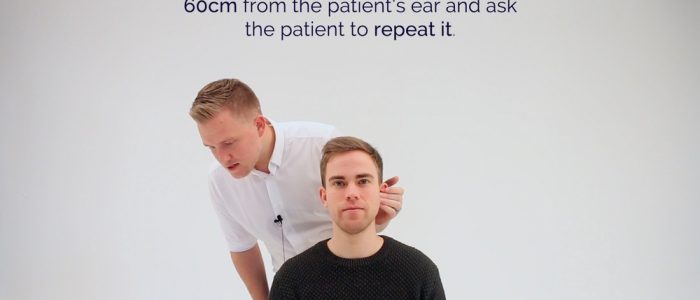- 📖 Geeky Medics OSCE Book
- ⚡ Geeky Medics Bundles
- ✨ 1300+ OSCE Stations
- ✅ OSCE Checklist PDF Booklet
- 🧠 UKMLA AKT Question Bank
- 💊 PSA Question Bank
- 💉 Clinical Skills App
- 🗂️ Flashcard Collections | OSCE, Medicine, Surgery, Anatomy
- 💬 SCA Cases for MRCGP
To be the first to know about our latest videos subscribe to our YouTube channel 🙌
Introduction
Rinne’s and Weber’s tests are simple tuning fork tests used to screen for the presence of conductive and sensorineural hearing loss. They are usually performed as part of a comprehensive ear examination.
It is important to be able to interpret the results of Rinne’s and Weber’s, as these tests frequently appear in OSCEs and written examinations.
How to perform Rinne’s test
1. Place a vibrating 512 Hz tuning fork firmly on the mastoid process (apply pressure to the opposite side of the head to make sure the contact is firm). This tests bone conduction.
2. Confirm the patient can hear the sound of the tuning fork and then ask them to tell you when they can no longer hear it.
3. When the patient can no longer hear the sound, move the tuning fork in front of the external auditory meatus to test air conduction.
4. Ask the patient if they can now hear the sound again. If they can hear the sound, it suggests air conduction is better than bone conduction, which is what would be expected in a healthy individual (this is often confusingly referred to as a “Rinne’s positive” result).
Interpretation of Rinne’s test
In healthy patients, air conduction (using the structures in the ear) should be better than bone conduction (conduction of vibrations via bone). Therefore, the patient should be able to hear the tuning fork held over the external auditory meatus (which is testing air conduction) for longer than the tuning fork held on the mastoid (testing bone conduction).
If there is a problem with air conduction (i.e. conductive hearing loss), then bone conduction may be better than air conduction. In this situation, the patient will be able to hear the tuning fork for longer when held on the mastoid (testing bone conduction) than when held over the external auditory meatus (testing air conduction).
However, a patient with significant sensorineural hearing loss may have a ‘false negative’ Rinne’s test, as they are unable to hear anything in the affected ear but bone vibrations may be transmitted to the unaffected ear.
How to perform Weber’s test
Explain to the patient that you are going to test their hearing using a tuning fork.
1. Tap a 512Hz tuning fork and place in the midline of the forehead. The tuning fork should be set in motion by striking it on your knee (not the patient’s knee or a table).
2. Ask the patient “Where do you hear the sound?”
A 512Hz tuning fork is used as it gives the best balance between time of decay and tactile vibration. Ideally, you want a tuning fork that has a long period of decay and cannot be detected by vibration sensation.
Interpretation of Weber’s test
Weber’s test should be assessed in context with the results of Rinne’s test before any diagnostic assumptions are made:
- Normal: sound is heard equally in both ears.
- Sensorineural hearing loss: sound is heard louder on the side of the intact ear.
- Conductive hearing loss: sound is heard louder on the side of the affected ear.*
*In conductive hearing loss, there is a relative improvement in bone conduction on the affected side. The affected ear has less environmental noise (due to the problem with air conduction). In addition, low-frequency sounds are ‘trapped’ within the inner ear by the obstruction leading to increased loudness in the affected ear. You can demonstrate this by speaking/humming, and then occluding an external auditory meatus. You will notice your voice is louder in the occluded ear.
Interpretation of Rinne’s and Weber’s tests
| Rinne’s test | Weber’s test | |
|
Normal |
Air conduction > bone conduction (Positive Rinne’s) |
Heard in the midline |
|
Conductive hearing loss |
Bone conduction > Air conduction (Negative Rinne’s) |
Heard in the bad ear |
|
Sensorineural hearing loss |
Air conduction > bone conduction (Positive Rinne’s) |
Heard in the good ear |
Conductive vs sensorineural hearing loss
| Conductive hearing loss | Sensorineural hearing loss | |
|
Definition |
External or middle ear pathology affects the conduction of sound into the inner ear |
Inner ear, cochlear or auditory nerve pathology impaired neuronal transmission to the brain |
|
Associated conditions |
|
|
|
Clinical features |
|
|
Key points
- Rinne’s and Weber’s are tuning fork tests (512 Hz tuning fork) used to screen for conductive and sensorineural hearing loss.
- In healthy individuals, Rinne’s test is positive (indicating air conduction is better than bone conduction) and Weber’s is heard in the midline.
- In patients with conductive hearing loss, Rinne’s test is negative (indicating bone conduction is better than air conduction) on the affected ear and Weber’s test localises to the affected ear.
- In sensorineural hearing loss, Rinne’s test is positive (indicating air conduction is better than bone conduction) and Weber’s is heard in the unaffected ear.







